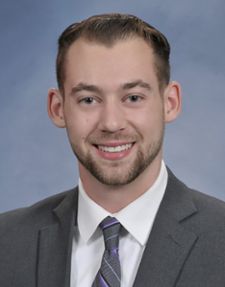MSU undergraduates publish on blog highlighting physiology in everyday life
While conducting outstanding research for capstone project honors, four physiology undergraduate students found a blog to share their work sponsored by the American Physiological Society (APS) that focuses on the presence of physiology in everyday life for both scientists and non-scientists.
Questions such as, what is physiology? where is physiology? and why does it matter to you? provide a focus for the APS I Spy Physiology Blog: Spotting Physiology in Everyday Life. Using these questions as a guide, physiologists search news stories, health articles and research snippets to find the multifaceted world of physiology in daily life, noting and explaining the path from lab research to healthy lifestyle recommendations often contained in writings geared to general audiences, not physiology specialists.
_225x315.jpg)
Matthew Cederman, Kayley Irwin, Gregory Olsen and Lauren Walkon wrote noteworthy research projects in PSL 475, “Capstone Laboratory in Physiology,” taught by Associate Professor of physiology Erica Wehrwein, and used part of their research to write an article for APS’s I Spy blog. Because it is very rare for undergraduate students to contribute articles to this blog, their success in publishing speaks to the excellence of their research and their presentation of it to audiences with varied education levels in science and physiology.
“I stress the importance of lay communication in my course,” Wehrwein said. “It is essential for scientists and clinicians to be able to speak to the public in accessible ways. The I Spy blog is a great example of translating science for a general audience. With the skills practiced in class, my students were ready to take on the challenge of writing about their Capstone project and physiology interests for a national audience.”

Matthew Cederman, a 2021 Honors College and physiology graduate with a bioethics minor, investigated which position—hands over the head or hands on the knees--allowed an athlete to best catch their breath and recover after one event and before the next, in Exercise Recovery: Which Body Position Is Best? He found that although putting your hands over your head causes the lungs to fill more vigorously than bending over, it also causes an athlete’s heart rate to increase, when recovery calls for a decreasing heart rate. So bending over is a better recovery position than stretching tall.
“For me, one of the most impactful skills is being able to educate others who have various degrees of knowledge on a given subject,” said Cederman, who is interested in finding quicker, safer and more optimal recovery paths for athletes and is pursuing medicine. “Publishing my article allowed me to further practice tailoring my communication and teaching to whomever I'm speaking with, which will directly benefit my future patients.”

Kayley Irwin, a 2021 Honors College graduate in physiology, explored exercise-associated hyponatremia (EAH), also known as water intoxication, in her blog post, Marathon Runners: There’s a Downside to Drinking Too Much Water. She explains sodium’s role in the body as an electrolyte important for maintaining the body’s water balance, which allows our nerves and muscles to work, and the difficulties that arise if people drink too much fluid and dilute their body’s sodium levels, including fatigue, nausea and headaches.
“It was incredibly gratifying to have the opportunity to discuss a topic I was passionate about on a national platform,” said Irwin, who is interested in how health care providers can better tailor injury guidelines and training protocols to improve performance in female athletes. “As I prepare to begin medical school in a month, I have been thinking about what aspects of health are most important to me. Projects such as this article have helped me explore different interests and develop a plan for what I want to accomplish through my medical career.”

Gregory Olsen, a 2021 Honors College and academic honors graduate in physiology as well as an Air Force ROTC program graduate, explored extended oxygen capacity in his blog post, Can You Win an Underwater Breath-holding Competition? He explains how the dive response uses the sympathetic and parasympathetic nervous systems simultaneously to increase the amount of time a person can spend underwater without taking a breath.
“I chose to study human physiology because I am passionate about the topic—and equally passionate about teaching the advanced concepts of physiology to people interested in learning more,” said Olsen, who plans to attend medical school. “Being able to publish an article on the I Spy blog meant I could share the same deeply intriguing knowledge that made me so passionate in a way that people who aren't experts can understand and learn about the incredible ways their body functions.”

Lauren Walkon, who will be an Honors College senior in physiology this fall, explored the value of sports drinks for recovering athletes in her article, Sip a Sports Drink to Keep the Electrolytes Flowing. She explained why electrolytes are necessary for the body to function properly, how intense physical activity causes electrolyte levels to drop and how the influx of electrolytes from sports drinks help raise electrolyte levels and regulate the movement of water into cells.
“I am very thankful to have had the opportunity to write an article for the I Spy Physiology Blog with the support of the Department of Physiology,” said Walkon, who is interested in finding ways to prevent injury in athletes and hopes to become a physician. “It is a privilege to share what I learned with a broader audience.”
Erica Wehrwein encouraged students to consider publishing on APS’s I Spy blog and has published frequently there herself, including for a wellness series. Her articles include Smile Rx: A Smile a Day Can Go a Long Way, The Power of Gratitude to Improve Mental and Physical Wellness and The Healing Power of Nature.
The American Physiological Society is a nonprofit devoted to fostering education, scientific research and dissemination of information in the physiological sciences. APS hopes to expand interest in the physiological sciences within the scientific community and among the public.
Banner image: While conducting research for capstone project honors, four physiology undergraduate students—Matthew Cederman, Kayley Irwin, Gregory Olsen and Lauren Walkon—found a blog sponsored by the American Physiological Society (APS) that focuses on the presence of physiology in everyday life for both scientists and non-scientists to share their work. Because it is very rare for undergraduate students to contribute articles to this blog, their success in publishing speaks to the excellence of their research and their presentation of it to audiences with varied education levels in science and physiology. Courtesy photo